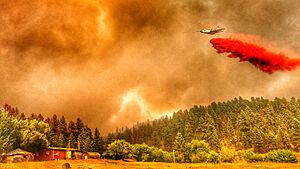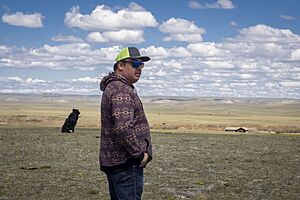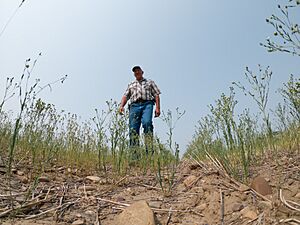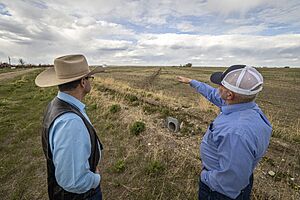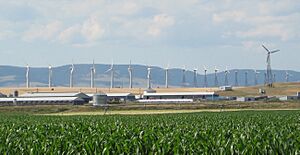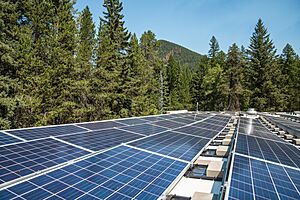Climate change in Montana facts for kids
Climate change is causing big changes in the US state of Montana. Summers are getting hotter, and snow is melting earlier in the spring. Trees are also dying because of dry weather, wildfires, and more forest insects. In the coming years, climate change will likely affect how much water is available, how well crops grow, and how often wildfires happen in Montana. The state and local governments are trying to help by using more clean energy and making plans to fight climate change.
Contents
Impacts
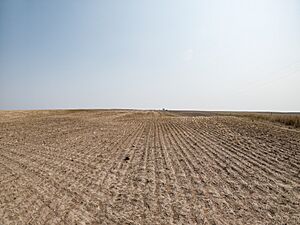
Water Resources
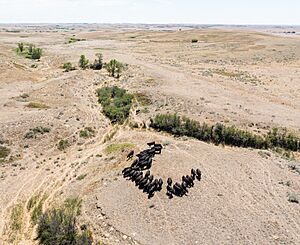
Experts say that Montana might have less water in some areas. Warmer temperatures in mountain states mean less snow will build up. This can lead to more floods in winter and less water in rivers during summer. This might make it harder for everyone to get enough water.
Montana is where many rivers start. So, changes to Montana's water can affect places far away. The state's Department of Environmental Quality says that climate change will harm water quality. This is because dirt and pollution can wash into rivers at unusual times.
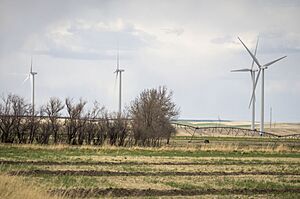
A report found that less snow could mean lower water levels in reservoirs in spring. Rivers might also have very low water in summer. Some rivers that usually flow all year might even dry up sometimes.
Warmer water is also a worry for fish. For example, native bull trout need very cold water to live. If the water gets too warm, they might not survive.
Forest Resources
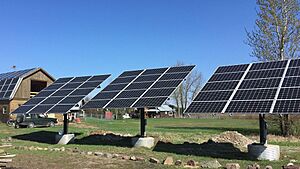
Montana's forests help fight climate change by soaking up carbon dioxide. They take in about 62% of the state's total pollution each year. The state also has many acres of land where new trees could be planted. These new forests could soak up even more carbon.
However, climate change could hurt Montana's forests. If the weather becomes drier and hotter, the forests might not be able to soak up as much carbon. They might even stop helping entirely.
Agriculture
Climate change affects farming differently in different places. In Montana, farming might not change much in the short term. For example, warmer weather can reduce wheat crops. But more carbon dioxide in the air can help plants grow. Also, warmer winters could mean farmers can grow two crops a year. However, warmer weather can also cause more weeds and pests.
Montana could still face problems from a warmer climate. Some crops that need cooler weather might not grow as well. New diseases and pests from warmer places could appear. There could also be more severe storms and droughts. For cattle, warmer weather means they eat less and grow slower. Livestock can also suffer from heat stress and get more parasites.
State Adaptation and Mitigation
Renewables
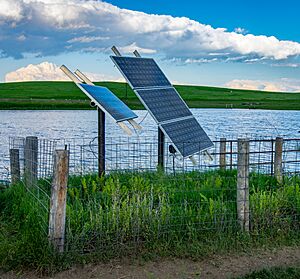
In 2005, Montana decided that public power companies must get at least 15% of their electricity from renewable energy by 2015. This plan also helps rural areas by making power companies buy energy from local companies. From 2010 to 2014, they had to buy 50 megawatts (MW) from these companies. By 2015, this went up to 75 MW. Power companies serving over 5,000 people must also promote renewable energy, especially in rural areas.
Montana mostly gets its renewable energy from wind energy, geothermal energy, and solar energy. The state offers many tax breaks and loans to help people and businesses use more renewable energy. This includes money for new projects, tax exemptions, and lower production taxes.
In 2009, Montana received $10.3 million from the federal government. This money was used to make state buildings more energy-efficient. It also helped expand renewable energy use and recycling. Some funds went to grants for new clean energy technologies. The Montana Department of Environmental Quality (DEQ) also offers low-interest loans. These loans help people, businesses, and non-profit groups install wind, solar, geothermal, hydro, and biomass energy systems.
Wind
Montana is one of the top five states for wind power. In 2009, wind power made up over 3% of all electricity in Montana. The state has some of the best wind speeds in the country. Most windy areas are in places with few people, near towns that support wind energy. The DEQ collects data from wind farms to help people interested in investing in wind energy. They also have a group that works to solve problems with wind energy and power lines.
Large wind farms in Montana include Glacier wind farm, Judith Gap wind farm, Diamond Willow wind farm, and Horseshoe Bend Wind Park. You can find detailed wind power maps on the MDEQ website.
Geothermal
In 2005, Montana started the Montana Geothermal Program. This program explores how much geothermal energy the state can use. Geothermal energy comes from heat inside the Earth. Experts say Montana has over 25,000 square miles of good sites for geothermal energy.
Montana has 15 high-temperature geothermal sites near cities like Helena and Bozeman. There are over 50 other geothermal areas across the state. Some sites have surface temperatures over 149°F, and deep underground, temperatures can be over 350°F. An online map shows details about Montana's main geothermal sites.
Solar
Most solar energy projects in Montana are for homes or small community buildings. These include homes, ranches, schools, and businesses. Experts are still studying if larger solar power plants would work well in Montana. Eastern Montana gets about 5 hours of full sun each day on average. Western Montana gets about 4.2 hours. This means Montana has enough sunlight for more solar energy in the future.
The State of Montana offers many tax breaks and loan programs to encourage solar energy projects. More details about these programs are available on the MDEQ website.
Lawsuits
Climate Change Trust Litigation
In 2011, some parents sued the state of Montana on behalf of their children. They argued that the air is a public resource that Montana must protect for its citizens. They said the state had a duty to protect this resource from climate change. The lawsuit listed many climate change impacts happening in Montana.
The Montana Supreme Court asked the state's Attorney General to respond to the lawsuit. The Attorney General argued that the case should start in a lower court, not the Supreme Court. The Supreme Court agreed. They said the case was too complex and needed a lower court to gather all the facts.
Held v. Montana
Held v. Montana was the first climate change lawsuit based on a state's constitution to go to trial in the United States. Sixteen young people from Montana, aged 2 to 18, filed the case in 2020.
The young people argued that Montana's support for the fossil fuel industry made climate change worse for them. They said this violated their right to a "clean and healthful environment" under Montana's constitution. In the trial, held in June 2023, the plaintiffs challenged a state law. This law stopped the state from considering greenhouse gas emissions when approving energy projects. On August 14, 2023, the judge ruled in favor of the young plaintiffs. The state said it would appeal this decision. Montana's Supreme Court heard arguments on the case in July 2024.
Statutes
In May 2023, lawmakers in Montana passed a new law. This law might be the strongest anti-climate action law in the country. It stops state agencies from looking at climate change impacts when they approve projects like coal mines and fuel power plants. An older state law already said the state couldn't consider climate impacts that were "regional, national, or global."


